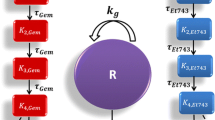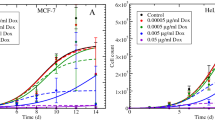Abstract
A mathematical model is presented to investigate the relationship between drug order and treatment response in gastric cancer chemotherapy involving a taxane (either paclitaxel or docetaxel) coupled with flavopiridol. To model treatment effects, we simulate treatment by bolus injection and employ a pulsing condition to indicate cell kill as well as instantaneous changes to the cell’s transition rates. Cell population growth is described using an ordinary differential equation model whereby we examine the treatment effects upon cells in various stages of the cell cycle. Ultimately, the results generated support prior clinical investigations which indicate that for an enhanced synergistic effect, flavopiridol must be administered following taxane therapy.
Similar content being viewed by others
References
Bast, R. C., et al. (Eds.) (2005). Cancer medicine. New York: Decker.
Ecker, J., & Kupferschmid, M. (2004). Introduction to operations research. Melbourne: Krieger.
Edelstein-Keshet, L. (1988). Mathematical models in biology. New York: McGraw-Hill.
Motwani, M., et al. (2003). Flavopiridol enhances the effect of docetaxel in vitro and in vivo in human gastric cancer cells. Mol. Cancer Ther., 2, 549–555.
Motwani, M., Delohery, T., & Schwartz, G. (1999). Sequential dependent enhancement of caspase activation and apoptosis by flavopiridol on paclitaxel-treated human gastric and breast cancer cells. Clin. Cancer Res., 5, 1876–1883.
Panetta, J., & Adam, J. (1995). A mathematical model of cycle-specific chemotherapy. Math. Comput. Model., 22, 67–82.
Roe-Dale, R., Isaacson, D., & Kupferschmid, M. (2010). A mathematical model of breast cancer treatment with CMF and doxorubicin. Bull. Math. Biol., 73, 585–608.
Schwartz, G. et al. (2002). Phase I study of the cycle-dependent kinase inhibitor flavopiridol in combination with paclitaxel in patients with advanced solid tumors. J. Clin. Oncol., 20, 2157–2170.
Shah, M., & Schwartz, G. (2001). Cell cycle-mediated drug resistance: an emerging concept in cancer therapy. Clin. Cancer Res., 7, 2168–2181.
Takahashi, M. (1966). Theoretical basis for cell cycle analysis I: labelled mitosis wave method. J. Theor. Biol., 13, 202–211.
Takahashi, M. (1968). Theoretical basis for cell cycle analysis II: further studies on labelled mitosis wave method. J. Theor. Biol., 18, 195–209.
Weldon, T. E. (1988). Mathematical models in cancer research. Bristol: Hilger.
Author information
Authors and Affiliations
Corresponding author
Rights and permissions
About this article
Cite this article
Roe-Dale, R., Isaacson, D. & Kupferschmid, M. A Mathematical Model of Cell Cycle Effects in Gastric Cancer Chemotherapy. Bull Math Biol 74, 159–174 (2012). https://doi.org/10.1007/s11538-011-9669-x
Received:
Accepted:
Published:
Issue Date:
DOI: https://doi.org/10.1007/s11538-011-9669-x




